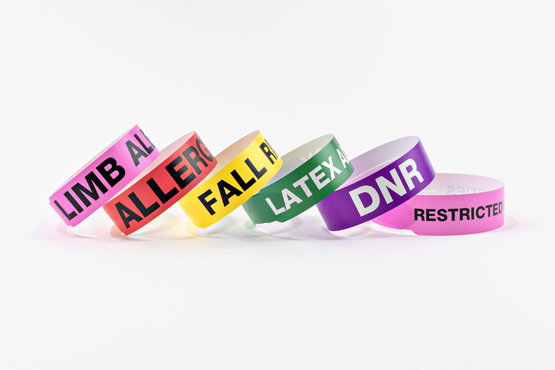Best Practices for Introducing a Patient Identification Band System in Your Clinic
Best Practices for Introducing a Patient Identification Band System in Your Clinic
Blog Article
Checking Out the Various Kinds Of Patient Identification Band Made Use Of in Clinical Facilities
In the detailed world of medical care, the important duty of Patient Identification bands frequently goes undetected. These bands, varying from basic paper wristbands to advanced RFID bands, develop the backbone of Patient safety and security procedures, guaranteeing accuracy in Patient Identification.
Recognizing the Importance of Patient Identification Bands
While they might appear like mere devices, Patient Identification bands play an important function in clinical centers. These bands offer as an essential tool for verifying Patient identification, avoiding medical mistakes connected to misidentification. Patient Identification bands likewise help in enhancing management jobs, ensuring exact record-keeping and invoicing.
Typical Paper Wristbands: Their Usage and Limitations
Typical paper wristbands have actually been a staple in Patient Identification throughout various clinical centers. While their usage is extensive, they nurture certain limitations that may impact their efficiency in Patient monitoring. This area will certainly concentrate on the range of their application and the intrinsic drawbacks associated with their usage.
Paper Wristbands: Usage Scope
In the realm of Patient Identification, paper wristbands have long held an essential role. These bands are generally made use of in outpatient settings, where the Patient's keep is short-lived. Regardless of innovations in technology, the simple paper wristband continues to be a trusted and cost-efficient option for Patient Identification in different medical care circumstances.
Limitations of Paper Wristbands
Regardless of their widespread usage, paper wristbands are not without their downsides. Their physical toughness is just one of the considerable limitations. Direct exposure to water, sweat, or misuse can provide them unreadable or also cause them to break down. On top of that, paper wristbands typically do not have the technical capabilities of even more modern alternatives, such as barcoding or RFID chips, restricting their functionality to just showing written info. The lack of ability to update or change the data on the wristband is another imperfection. If the details is handwritten, readability can be endangered, leading to potential misidentification. Paper wristbands can cause discomfort or skin irritation to some patients, specifically when used for prolonged periods.
Barcoded Wristbands: Advancements in Patient Identification
While Patient Identification has actually long been a critical facet of healthcare, the advent of barcoded wristbands signifies a considerable leap onward. These bands utilize the simplicity of barcoding modern technology, allowing for Patient info to be promptly scanned and accessed. They improve the rate and precision of Patient Identification, decreasing the threat of medical mistakes connected to misidentification.
Superhigh Frequency Identification (RFID) Bands: a Step Towards Futuristic Health Care
The evolution of Patient Identification bands has actually caused the emergence of Superhigh frequency Identification (RFID) Bands (patient identification band). These cutting-edge tools existing crucial benefits for medical care facilities, providing a much more reliable and technologically advanced means of Patient Identification. The execution of RFID in healthcare is a substantial step towards a more advanced approach to Patient monitoring and safety and security
Recognizing RFID Bands

RFID Bands: Trick Benefits
Largely, these bands improve Patient security by giving accurate, instant Identification, therefore decreasing medical errors. RFID bands can save a large quantity of Patient information, including clinical history and allergies, enabling personalized treatment. Generally, RFID bands represent a considerable improvement in Patient Identification technology, profiting both people and medical care suppliers.
Implementing RFID in Healthcare
These bands provide a smooth way to track and recognize clients, guaranteeing their safety and security and enhancing efficiency in therapy procedures. RFID bands minimize clinical errors by giving accurate Patient Identification, which is important in protecting against misdiagnosis or wrong medicine administration. Therefore, the execution of RFID bands is a considerable action towards enhancing Patient safety and health care delivery.

Color-Coded Wristbands: Aiding in Quick and Accurate Diagnosis
In the bustling atmosphere of a clinical facility, color-coded wristbands have arised as vital tools for swift and specific Identification of an individual's clinical condition. These wristbands, used by people, carry certain colors that correspond to different clinical problems or statuses. This system is developed to use prompt visual signs to healthcare providers, enhancing Patient security and care top quality.
Strategies for Effective Application and Administration of Patient ID Bands
Achieving optimal use Patient Identification bands requires a well-structured method for their application and monitoring. The initial action entails training all health personnel on the significance of correctly applying and reading these bands. Healthcare facilities must standardize the use of ID bands across all divisions, making certain harmony and lowering disparities. Routine audits must be carried out to confirm adherence to policies and to rectify any kind of incongruities. Patient education and learning is likewise vital; individuals should understand the objective of the bands and the requirement for their continuous wear. patient identification browse this site band. It's crucial to have a back-up plan in area, such as barcode scanning or biometrics, to make sure that Patient Identification is never compromised.
Final thought
Patient Identification bands are essential in medical centers to ensure security and precision. Standard paper, barcoded, RFID, and color-coded wristbands each hold special advantages, ranging from cost-effectiveness to advanced data storage and instant medical notifies. Reliable application and monitoring of these bands can considerably decrease clinical mistakes, improve effectiveness, and boost overall Patient treatment. Therefore, understanding and utilizing these Identification tools is vital for keeping high standards in healthcare.
These bands, varying from easy paper wristbands to sophisticated RFID bands, create the backbone of Patient safety and security procedures, making sure accuracy in Patient Identification.The advancement of Patient Identification bands has brought concerning the development of Radio Regularity Identification (RFID) Bands. Overall, RFID bands represent a significant advancement in Patient Identification innovation, profiting both people and health care companies.
RFID bands minimize clinical mistakes by supplying accurate Patient Identification, which is visit this website essential in protecting against misdiagnosis or incorrect medication administration. Patient education is likewise vital; people have to understand the objective of the bands and the requirement for their consistent wear.
Report this page